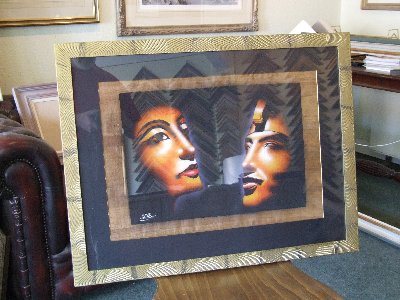
Click the pic for bigger image.

framemaker wrote:Great looking finish!
I have seen a few mentions on the forum of ripple paint/coat, never heard of this before, is it a trade name or do you mix it yourself?
It works quite well with thinner coats, where gravity has less effect than with heavier coats. So far I have not tried this with ripple coat, but it works quite well with acrylic paint thickened with cheap baby powder. It still needs to be quite thin to work well, so don't over do the baby powder. Thicker acrylic paints may not need any thickening at all.prospero wrote:
Yes, I've even thought about buying some to refinish.prospero wrote:Have you seen some of the frames in Simons ready-made cat?
How about one of those router lathes or an architectural mill to go with your router, so you can do "over the top" massive rope twist mouldings and all the other fancy stuff?prospero wrote:Router table, planer-thicknesser and a decent table saw. Then I can really go to town.
Judging by the samples we've seen of your fabulous work, Prospero, I'd say it'll be less "town" and more "bright lights, big city"!prospero wrote:When I get my outside 'workshop' fitted out I hope to get some more woodworking gear. Router table, planer-thicknesser and a decent table saw. Then I can really go to town.
 .Briseann an dúchas trí shuiligh an chuit.
.Briseann an dúchas trí shuiligh an chuit.I must admit if it was not for Prospero starting this thread, I don't think I would have even thought about the possibilty of doing a finish like that. Once you have seen something like this, then you can begin to see the posibilities.prospero wrote:It's done with a heavy coat of ripple paint and a graining comb.......
you can see along the lower edge how the light reacts with the gold.
Moglet wrote: Judging by the samples we've seen of your fabulous work, Prospero, I'd say it'll be less "town" and more "bright lights, big city"!
Loved the frame in your pic!A terrific inspiration to those considering undertaking HF work, and a great example of the artistry of a truly great framer.
I could not agree more, the possibilties for hand finishing are endless, and I think the best way to start is by making up barewood samples and just experimenting with different ideas. If you have the desire and are interested in doing hand finishing on frames then thats a good start and through trial end error you will soon get the basics.Not your average framer wrote:
I must admit if it was not for Prospero starting this thread, I don't think I would have even thought about the possibilty of doing a finish like that. Once you have seen something like this, then you can begin to see the posibilities.
I hope that those thinking of taking the plunge with hand-finishing can see that we are all learning from each other and I trust that I am not alone in encouraging those who might be a little daunted by, but would like be able to do some hand finishing of their own, to give it a try. I'm not suggesting it will necessarily be instant success, but the secret is to try it and to practice until you get there.
 .Briseann an dúchas trí shuiligh an chuit.
.Briseann an dúchas trí shuiligh an chuit. .Briseann an dúchas trí shuiligh an chuit.
.Briseann an dúchas trí shuiligh an chuit.Errr.. well it's not really a papyrus as such. It's actually painted on woven bark fibres. Same ilk though.Moglet wrote:I must admit that I'm really taken with the idea of textured effects.
Prospero, I've been meaning to ask another question about your Egyptian piece at the top of the thread. As well as the HF effect on the frame, I really like the mount that the papyrus is floated on. Is that more HF work?
Already spotted!prospero wrote:Check out the gilded bevel on the mount.
Oh so true!Prospero wrote:I like to see this type of artwork ("ethnic", for want of a better term) in a frame that suits it. The traditional European designs often clash.
I find it curious how certain common traits appear in art of different ethnicities. Celtic art also uses those little dots for emphasis, too. They're usually red, and the technique is referred to as "rubrication."Prospero wrote:I have a big Austrailian aboriginal painting to do .... the design is traditional, lots of little dots.
 .Briseann an dúchas trí shuiligh an chuit.
.Briseann an dúchas trí shuiligh an chuit.